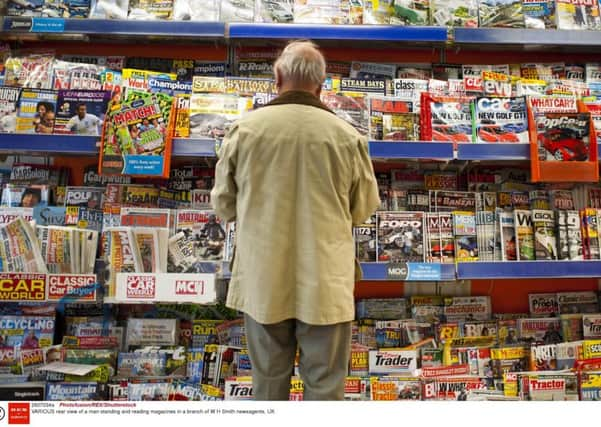Martyn McLaughlin: Once it was the nation's newsagent '“ now we hate it


Poor old WH Smith. For the eighth consecutive year, the stalwart of high streets, railway stations and airport terminals the nation over has been shamed by shoppers who have named it one of Britain’s worst retailers.
In a survey of more than 10,000 people by the consumer watchdog, Which?, the chain came bottom of the pile, and was roundly chastised by those who believe its glory years are well behind it.
Advertisement
Hide AdAdvertisement
Hide AdThose polled singled out its poor customer service, high prices and substandard stores. As one customer put it, the WH Smith of 2018 is “hugely inferior to what it was in the past”. For a once ubiquitous retailer, the findings represent yet another fall from grace, and WH Smith has not had its troubles to seek of late.
It endured a backlash for overcharging customers for toothpastes and other toiletries in its hospital shops. Only last month, it posted a drop in its half-year pre-tax profits, with a six per cent slump in its high street earnings, down to £50 million.
It is all a far cry from its halcyon days two decades ago. Back then, I landed a job working at its Greenock branch as I was going through university; in the pantheon of poorly paid weekend work for struggling undergraduates, I thought I had struck gold.
The position allowed me to cadge as many free newspapers as I wished, and offered the opportunity to play Led Zeppelin’s Physical Graffiti at full volume in the upstairs record bar, much to the disapproval of my colleagues. When you are 18, these things matter.
Behind the scenes, the chain, established in 1792, was in rude health. In 1998, the year I began working there, it had pocketed £435m by selling off its interests in Waterstones and Virgin Our Price, money it used to acquire John Menzies, until then one of its main competitors in Scotland.
By the year’s end, its retail division had generated revenues of £1.1 billion, a figure which almost doubled once its news distribution operation was taken into account. Together, they helped the company post a record profit of £101m.
The future seemed bright. At the time, WH Smith was selling 35 million books in the UK every year. But 1998 also marked the UK launch of a little-known online retailer by the name of Amazon. The wheels for a gradual and inglorious demise were set in motion.
Nowadays, it is easy to empathise with the punters who took part in the Which? survey. Visiting a WH Smith store feels like entering a portal to the past. Its shops are dimly lit, and the layout is both confusing and inconsistent. It has a reasonable range of stock, but it feels very much like a jack of all trades, one which lacks the choice and affordability of its competitors.
Advertisement
Hide AdAdvertisement
Hide AdIt is little wonder that @WHS_Carpet, a spoof Twitter account in operation since 2013, has attracted nearly 19,000 followers thanks to its scathing snapshots of dubious in-store promotions. Its recent photographs show one shop selling chocolate Easter bunnies and half-price chocolate Santas side by side, as well as a row of self-service tills, all of which are displaying error messages.
There is no straightforward route to recovery for WH Smith, which continues to serve 12 million customers a week, although its latest plan, which will see it renew its focus on stationery, seems like a sensible step. Yet perhaps the most obvious starting point for the firm’s executives would be to look at the Which? survey. Granted, it may make for painful reading, but it could also offer an instructive hint or two. Predictably, the top ten rated shops include longstanding favourites like Ikea and John Lewis, but looking elsewhere, the inclusion of other, less well-known retailers, proves telling.
In joint first place, for instance, is Savers. The Durham-founded chain specialises in discounted health, beauty, and homeware products. Compared to the likes of Boots, its physical stores cut a homespun presence, with shelves stacked high and precious few frills or thrills.
While there was a time – think 1998, for example – when such unsophisticated retailers went unheralded, their almost utilitarian purpose is now firmly in vogue.
There is no fiendishly clever strategy at play. Shoppers simply want recognisable brand names at cheap prices, and rather than paying a few pounds extra in big name chains, they are voting with their feet.
The same is true of at least four other entries in the top ten. Take Bodycare, which also takes pride in its discount retailer status. Its genesis can be traced back to a market stall in Skelmersdale. Now, it has more than 130 stores with a turnover of more than £130m.
Or there is The Perfume Shop, which eschews the pampering and one-to-one service of major outlets like House of Fraser. Instead, its fragrances are kept behind a counter. Do the punters care? Seemingly not, especially if they can save a bob or two on their favourite scent.
Two other entries in the top ten – Screwfix and Toolstation – may offer a completely different range of goods, but they adopt to a similar approach to the budget beauty shops by undercutting major DIY outlets when it comes to tools, accessories, and hardware.
Advertisement
Hide AdAdvertisement
Hide AdThere are lessons here for WH Smith. It is no longer the nation’s newsagent, and its days as the go-to place for a newly published novel are in the past. But if it can focus on what it does best, there is a chance it can at least cast off the shackles of being named Britain’s worst shop.
